Galaxy
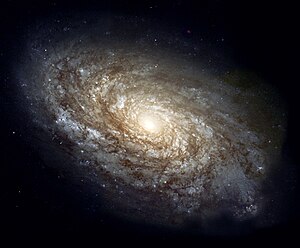 galaxy is a massive, gravitationally bound system that consists of stars and stellar remnants, an interstellar medium of gas dust, and an important but poorly understood component tentatively dubbed dark matter.[1][2] The name is from the Greek root galaxias [γαλαξίας], literally meaning "milky", a reference to the Milky Way galaxy. Typical galaxies range from dwarfs with as few as ten million (107) stars,[3] up to giants with a hundred trillion (1014) stars,[4] all orbiting the galaxy's center of mass. Galaxies may contain many star systems, star clusters, and various interstellar clouds. The Sun is one of the stars in the Milky Way galaxy; the Solar System includes the Earth and all the other objects that orbit the Sun.
galaxy is a massive, gravitationally bound system that consists of stars and stellar remnants, an interstellar medium of gas dust, and an important but poorly understood component tentatively dubbed dark matter.[1][2] The name is from the Greek root galaxias [γαλαξίας], literally meaning "milky", a reference to the Milky Way galaxy. Typical galaxies range from dwarfs with as few as ten million (107) stars,[3] up to giants with a hundred trillion (1014) stars,[4] all orbiting the galaxy's center of mass. Galaxies may contain many star systems, star clusters, and various interstellar clouds. The Sun is one of the stars in the Milky Way galaxy; the Solar System includes the Earth and all the other objects that orbit the Sun.
Historically, galaxies have been categorized according to their apparent shape (usually referred to as their visual morphology). A common form is the elliptical galaxy,[5] which has an ellipse-shaped light profile. Spiral galaxies are disk-shaped assemblages with dusty, curving arms. Galaxies with irregular or unusual shapes are known as irregular galaxies, and typically result from disruption by the gravitational pull of neighboring galaxies. Such interactions between nearby galaxies, which may ultimately result in galaxies merging, may induce episodes of significantly increased star formation, producing what is called a starburst galaxy. Small galaxies that lack a coherent structure could also be referred to as irregular galaxies.[6]
There are probably more than 170 billion (1.7 × 1011) galaxies in the observable universe.[7][8] Most galaxies are 1,000 to 100,000[9] parsecs in diameter and are usually separated by distances on the order of millions of parsecs (or megaparsecs).[10] Intergalactic space (the space between galaxies) is filled with a tenuous gas of an average density less than one atom per cubic meter. The majority of galaxies are organized into a hierarchy of associations called clusters, which, in turn, can form larger groups called superclusters. These larger structures are generally arranged into sheets and filaments, which surround immense voids in the universe.[11]
Although it is not yet well understood, dark matter appears to account for around 90% of the mass of most galaxies. Observational data suggests that supermassive black holes may exist at the center of many, if not all, galaxies. They are proposed to be the primary cause of active galactic nuclei found at the core of some galaxies. The Milky Way galaxy appears to harbor at least one such object within its nucleus.[12]
Etymology
The word galaxy derives from the Greek term for our own galaxy, galaxias (γαλαξίας), or kyklos galaktikos, meaning "milky circle" for its appearance in the sky. In Greek mythology, Zeus places his son born by a mortal woman, the infant Heracles, on Hera's breast while she is asleep so that the baby will drink her divine milk and will thus become immortal. Hera wakes up while breastfeeding and then realizes she is nursing an unknown baby: she pushes the baby away and a jet of her milk sprays the night sky, producing the faint band of light known as the Milky Way.[13]
In the astronomical literature, the capitalized word 'Galaxy' is used to refer to our galaxy, the Milky Way, to distinguish it from the billions of other galaxies. The term Milky Way first appeared in the English language in a poem by Chaucer.
"See yonder, lo, the Galaxyë
Which men clepeth the Milky Wey,
For hit is whyt."—Geoffrey Chaucer. The House of Fame, c. 1380.[14]
When William Herschel constructed his catalog of deep sky objects, he used the name spiral nebula for certain objects such as M31. These would later be recognized as immense conglomerations of stars, when the true distance to these objects began to be appreciated, and they would be termed island universes. However, the word Universe was understood to mean the entirety of existence, so this expression fell into disuse and the objects instead became known as galaxies.[15]
Observation history
The realization that we live in a galaxy, and that there were, in fact, many other galaxies, parallels discoveries that were made about the Milky Way and other nebulae in the night sky.
[edit]The Milky Way
The Greek philosopher Democritus (450–370 B.C.) proposed that the bright band on the night sky known as the Milky Way might consist of distant stars.[16]Aristotle (384–322 B.C.), however, believed the Milky Way to be caused by "the ignition of the fiery exhalation of some stars which were large, numerous and close together" and that the "ignition takes place in the upper part of the atmosphere, in the region of the world which is continuous with the heavenly motions."[17] The Neoplatonist philosopher Olympiodorus the Younger (c. 495–570 A.D.) criticized this view, arguing that if the Milky Way were sublunary it should appear different at different times and places on the Earth, and that it should have parallax, which it does not. In his view, the Milky Way was celestial. This idea would be influential later in the Islamic world.[18]
The Arabian astronomer, Alhazen (965–1037), made the first attempt at observing and measuring the Milky Way's parallax,[19] and he thus "determined that because the Milky Way had no parallax, it was very remote from the Earth and did not belong to the atmosphere."[20] The Persian astronomer Abū Rayhān al-Bīrūnī (973–1048) proposed the Milky Way galaxy to be "a collection of countless fragments of the nature of nebulous stars."[21][unreliable source?] TheAndalusian astronomer Ibn Bajjah ("Avempace", d. 1138) proposed that the Milky Way was made up of many stars that almost touch one another and appear to be a continuous image due to the effect of refraction from sublunary material,[17][22] citing his observation of the conjunction of Jupiter and Mars as evidence of this occurring when two objects are near.[17] The Syrian-born Ibn Qayyim Al-Jawziyya (1292–1350) proposed the Milky Way galaxy to be "a myriad of tiny stars packed together in the sphere of the fixed stars".[23]
Actual proof of the Milky Way consisting of many stars came in 1610 when Galileo Galilei used a telescope to study the Milky Way and discovered that it is composed of a huge number of faint stars.[24] In 1750 Thomas Wright, in his An original theory or new hypothesis of the Universe, speculated (correctly) that the galaxy might be a rotating body of a huge number of stars held together bygravitational forces, akin to the solar system but on a much larger scale. The resulting disk of stars can be seen as a band on the sky from our perspective inside the disk.[25] In a treatise in 1755,Immanuel Kant elaborated on Wright's idea about the structure of the Milky Way.The first attempt to describe the shape of the Milky Way and the position of the Sun in it was carried out by William Herschel in 1785 by carefully counting the number of stars in different regions of the sky. He produced a diagram of the shape of the galaxy with the solar system close to the center.[26][27] Using a refined approach, Kapteyn in 1920 arrived at the picture of a small (diameter about 15 kiloparsecs) ellipsoid galaxy with the Sun close to the center. A different method by Harlow Shapley based on the cataloguing of globular clusters led to a radically different picture: a flat disk with diameter approximately 70 kiloparsecs and the Sun far from the center.[25] Both analyses failed to take into account the absorption of light by interstellar dust present in the galactic plane, but after Robert Julius Trumpler quantified this effect in 1930 by studying open clusters, the present picture of our galaxy, the Milky Way, emerged.[28]
[edit]Distinction from other nebulae
In the 10th century, the Persian astronomer, Abd al-Rahman al-Sufi (known in the West as Azophi), made the earliest recorded observation of the Andromeda Galaxy, describing it as a "small cloud".[29] Al-Sufi also identified the Large Magellanic Cloud, which is visible from Yemen, though not from Isfahan; it was not seen by Europeans until Magellan's voyage in the 16th century.[30][31] These were the first galaxies other than the Milky Way to be observed from Earth. Al-Sufi published his findings in his Book of Fixed Stars in 964.
In 1750 Thomas Wright, in his An original theory or new hypothesis of the Universe, speculated (correctly) that Milky Way was a flattened disk of stars, and that some of the nebulae visible in the night sky might be separate Milky Ways.[25][32] In 1755 Immanuel Kant introduced the term "island universe" for these distant nebulae.
Toward the end of the 18th century, Charles Messier compiled a catalog containing the 109 brightest nebulae (celestial objects with a nebulous appearance), later followed by a larger catalog of 5,000 nebulae assembled by William Herschel.[25] In 1845, Lord Rosse constructed a new telescope and was able to distinguish between elliptical and spiral nebulae. He also managed to make out individual point sources in some of these nebulae, lending credence to Kant's earlier conjecture.[33]
In 1912, Vesto Slipher made spectrographic studies of the brightest spiral nebulae to determine if they were made from chemicals that would be expected in a planetary system. However, Slipher discovered that the spiral nebulae had high red shifts, indicating that they were moving away at rate higher than the Milky Way's escape velocity. Thus they were not gravitationally bound to the Milky Way, and were unlikely to be a part of the galaxy.[34][35]
In 1917, Heber Curtis had observed a nova S Andromedae within the "Great Andromeda Nebula" (Messier object M31). Searching the photographic record, he found 11 more novae. Curtis noticed that these novae were, on average, 10 magnitudes fainter than those that occurred within our galaxy. As a result he was able to come up with a distance estimate of 150,000 parsecs. He became a proponent of the so-called "island universes" hypothesis, which holds that spiral nebulae are actually independent galaxies.[36]In 1920 the so-called Great Debate took place between Harlow Shapley and Heber Curtis, concerning the nature of the Milky Way, spiral nebulae, and the dimensions of the Universe. To support his claim that the Great Andromeda Nebula was an external galaxy, Curtis noted the appearance of dark lanes resembling the dust clouds in the Milky Way, as well as the significant Doppler shift.[37]
The matter was conclusively settled in the early 1920s. In 1922, astronomer Ernst Öpik gave a distance determination which supported the theory that the Andromeda Nebula is indeed a distant extra-galactic object.[38] Using the new 100 inch Mt. Wilson telescope, Edwin Hubble was able to resolve the outer parts of some spiral nebulae as collections of individual stars and identified some Cepheid variables, thus allowing him to estimate the distance to the nebulae: they were far too distant to be part of the Milky Way.[39] In 1936 Hubble produced a classification system for galaxies that is used to this day, theHubble sequence.[40]
[edit]Modern research
In 1944, Hendrik van de Hulst predicted microwave radiation at a wavelength of 21 cm resulting from interstellar atomic hydrogen gas;[41] this radiation was observed in 1951. The radiation allowed for much improved study of the Milky Way Galaxy, since it is not affected by dust absorption and its Doppler shift can be used to map the motion of the gas in the Galaxy. These observations led to the postulation of a rotating bar structure in the center of the Galaxy.[42] With improved radio telescopes, hydrogen gas could also be traced in other galaxies.
In the 1970s it was discovered in Vera Rubin's study of the rotation speed of gas in galaxies that the total visible mass (from the stars and gas) does not properly account for the speed of the rotating gas. This galaxy rotation problem is thought to be explained by the presence of large quantities of unseen dark matter.[43][44]
Beginning in the 1990s, the Hubble Space Telescope yielded improved observations. Among other things, it established that the missing dark matter in our galaxy cannot solely consist of inherently faint and small stars.[45] The Hubble Deep Field, an extremely long exposure of a relatively empty part of the sky, provided evidence that there are about 125 billion (1.25×1011) galaxies in the universe.[46] Improved technology in detecting the spectra invisible to humans (radio telescopes, infrared cameras, and x-ray telescopes) allow detection of other galaxies that are not detected by Hubble. Particularly, galaxy surveys in the zone of avoidance (the region of the sky blocked by the Milky Way) have revealed a number of new galaxies.[47]
The most distant galaxy as seen in the Hubble Ultra Deep Field is UDFy-38135539 approximately 13 billion ly from Earth.
Spirals
Main articles: Spiral galaxy and Barred spiral galaxy
Spiral galaxies consist of a rotating disk of stars and interstellar medium, along with a central bulge of generally older stars. Extending outward from the bulgeare relatively bright arms. In the Hubble classification scheme, spiral galaxies are listed as type S, followed by a letter (a, b, or c) that indicates the degree of tightness of the spiral arms and the size of the central bulge. An Sa galaxy has tightly wound, poorly defined arms and possesses a relatively large core region. At the other extreme, an Sc galaxy has open, well-defined arms and a small core region.[50]
In spiral galaxies, the spiral arms do have the shape of approximate logarithmic spirals, a pattern that can be theoretically shown to result from a disturbance in a uniformly rotating mass of stars. Like the stars, the spiral arms rotate around the center, but they do so with constant angular velocity. The spiral arms are thought to be areas of high density matter, or "density waves". As stars move through an arm, the space velocity of each stellar system is modified by the gravitational force of the higher density. (The velocity returns to normal after the stars depart on the other side of the arm.) This effect is akin to a "wave" of slowdowns moving along a highway full of moving cars. The arms are visible because the high density facilitates star formation, and therefore they harbor many bright and young stars.
A majority of spiral galaxies have a linear, bar-shaped band of stars that extends outward to either side of the core, then merges into the spiral arm structure.[51] In the Hubble classification scheme, these are designated by an SB, followed by a lower-case letter (a, b or c) that indicates the form of the spiral arms (in the same manner as the categorization of normal spiral galaxies). Bars are thought to be temporary structures that can occur as a result of a density wave radiating outward from the core, or else due to a tidal interaction with another galaxy.[52] Many barred spiral galaxies are active, possibly as a result of gas being channeled into the core along the arms.[53]
Other morphologies
Peculiar galaxies are galactic formations that develop unusual properties due to tidal interactions with other galaxies. An example of this is the ring galaxy, which possesses a ring-like structure of stars and interstellar medium surrounding a bare core. A ring galaxy is thought to occur when a smaller galaxy passes through the core of a spiral galaxy.[57] Such an event may have affected the Andromeda Galaxy, as it displays a multi-ring-like structure when viewed in infrared radiation.[58]
A lenticular galaxy is an intermediate form that has properties of both elliptical and spiral galaxies. These are categorized as Hubble type S0, and they possess ill-defined spiral arms with an elliptical halo of stars.[59] (Barred lenticular galaxies receive Hubble classification SB0.)
In addition to the classifications mentioned above, there are a number of galaxies that can not be readily classified into an elliptical or spiral morphology. These are categorized as irregular galaxies. An Irr-I galaxy has some structure but does not align cleanly with the Hubble classification scheme. Irr-II galaxies do not possess any structure that resembles a Hubble classification, and may have been disrupted.[60] Nearby examples of (dwarf) irregular galaxies include the Magellanic Clouds.
[edit]Dwarfs
Main article: Dwarf galaxy
Despite the prominence of large elliptical and spiral galaxies, most galaxies in the universe appear to be dwarf galaxies. These galaxies are relatively small when compared with other galactic formations, being about one hundredth the size of the Milky Way, containing only a few billion stars. Ultra-compact dwarf galaxies have recently been discovered that are only 100 parsecs across.[61]
Many dwarf galaxies may orbit a single larger galaxy; the Milky Way has at least a dozen such satellites, with an estimated 300–500 yet to be discovered.[62]Dwarf galaxies may also be classified as elliptical, spiral, or irregular. Since small dwarf ellipticals bear little resemblance to large ellipticals, they are often calleddwarf spheroidal galaxies instead.
A study of 27 Milky Way neighbors found that dwarf galaxies were all approximately 10 million solar masses, regardless of whether they have thousands or millions of stars. This has led to the suggestion that galaxies are largely formed by dark matter, and that the minimum size may indicate a form of warm dark matter incapable of gravitational coalescence on a smaller scale.[63]
Unusual dynamics and activities
[edit]Interacting
Main article: Interacting galaxy
The average separation between galaxies within a cluster is a little over an order of magnitude larger than their diameter. Hence interactions between these galaxies are relatively frequent, and play an important role in their evolution. Near misses between galaxies result in warping distortions due to tidal interactions, and may cause some exchange of gas and dust.[64][65]
Collisions occur when two galaxies pass directly through each other and have sufficient relative momentum not to merge. The stars within these interacting galaxies will typically pass straight through without colliding. However, the gas and dust within the two forms will interact. This can trigger bursts of star formation as the interstellar medium becomes disrupted and compressed. A collision can severely distort the shape of one or both galaxies, forming bars, rings or tail-like structures.[64][65]
At the extreme of interactions are galactic mergers. In this case the relative momentum of the two galaxies is insufficient to allow the galaxies to pass through each other. Instead, they gradually merge together to form a single, larger galaxy. Mergers can result in significant changes to morphology, as compared to the original galaxies. In the case where one of the galaxies is much more massive, however, the result is known ascannibalism. In this case the larger galaxy will remain relatively undisturbed by the merger, while the smaller galaxy is torn apart. The Milky Way galaxy is currently in the process of cannibalizing the Sagittarius Dwarf Elliptical Galaxy and the Canis Major Dwarf Galaxy.[64][65]
[edit]Starburst
Main article: Starburst galaxy
Stars are created within galaxies from a reserve of cold gas that forms into giant molecular clouds. Some galaxies have been observed to form stars at an exceptional rate, known as a starburst. Should they continue to do so, however, they would consume their reserve of gas in a time frame lower than the lifespan of the galaxy. Hence starburst activity usually lasts for only about ten million years, a relatively brief period in the history of a galaxy. Starburst galaxies were more common during the early history of the universe,[67] and, at present, still contribute an estimated 15% to the total star production rate.[68]
Starburst galaxies are characterized by dusty concentrations of gas and the appearance of newly formed stars, including massive stars that ionize the surrounding clouds to create H II regions.[69] These massive stars produce supernova explosions, resulting in expanding remnants that interact powerfully with the surrounding gas. These outbursts trigger a chain reaction of star building that spreads throughout the gaseous region. Only when the available gas is nearly consumed or dispersed does the starburst activity come to an end.[67]
Starbursts are often associated with merging or interacting galaxies. The prototype example of such a starburst-forming interaction is M82, which experienced a close encounter with the larger M81. Irregular galaxies often exhibit spaced knots of starburst activity.[70]
[edit]Active nucleus
Main article: Active galactic nucleus
A portion of the galaxies we can observe are classified as active. That is, a significant portion of the total energy output from the galaxy is emitted by a source other than the stars, dust and interstellar medium.
The standard model for an active galactic nucleus is based upon an accretion disc that forms around a supermassive black hole (SMBH) at the core region. The radiation from an active galactic nucleus results from the gravitational energy of matter as it falls toward the black hole from the disc.[71] In about 10% of these objects, a diametrically opposed pair of energetic jets ejects particles from the core at velocities close to the speed of light. The mechanism for producing these jets is still not well understood.[72]Active galaxies that emit high-energy radiation in the form of x-rays are classified as Seyfert galaxies or quasars, depending on the luminosity. Blazars are believed to be an active galaxy with a relativistic jet that is pointed in the direction of the Earth. A radio galaxy emits radio frequencies from relativistic jets. A unified model of these types of active galaxies explains their differences based on the viewing angle of the observer.[72]
Possibly related to active galactic nuclei (as well as starburst regions) are low-ionization nuclear emission-line regions (LINERs). The emission from LINER-type galaxies is dominated by weakly ionized elements.[73] Approximately one-third of nearby galaxies are classified as containing LINER nuclei.[71][73][74]
[edit]Formation and evolution
Main article: Galaxy formation and evolution
The study of galactic formation and evolution attempts to answer questions regarding how galaxies formed and their evolutionary path over the history of the universe. Some theories in this field have now become widely accepted, but it is still an active area in astrophysics.
[edit]Formation
Current cosmological models of the early Universe are based on the Big Bang theory. About 300,000 years after this event, atoms of hydrogen and helium began to form, in an event called recombination. Nearly all the hydrogen was neutral (non-ionized) and readily absorbed light, and no stars had yet formed. As a result this period has been called the "Dark Ages". It was from density fluctuations (or anisotropic irregularities) in this primordial matter that larger structures began to appear. As a result, masses of baryonic matter started to condense within cold dark matter halos.[75] These primordial structures would eventually become the galaxies we see today.
Evidence for the early appearance of galaxies was found in 2006, when it was discovered that the galaxy IOK-1 has an unusually high redshift of 6.96, corresponding to just 750 million years after the Big Bang and making it the most distant and primordial galaxy yet seen.[76] While some scientists have claimed other objects (such as Abell 1835 IR1916) have higher redshifts (and therefore are seen in an earlier stage of the Universe's evolution), IOK-1's age and composition have been more reliably established. The existence of such early protogalaxies suggests that they must have grown in the so-called "Dark Ages".[75]
The detailed process by which such early galaxy formation occurred is a major open question in astronomy. Theories could be divided into two categories: top-down and bottom-up. In top-down theories (such as the Eggen–Lynden-Bell–Sandage [ELS] model), protogalaxies form in a large-scale simultaneous collapse lasting about one hundred million years.[77] In bottom-up theories (such as the Searle-Zinn [SZ] model), small structures such as globular clusters form first, and then a number of such bodies accrete to form a larger galaxy.[78] Modern theories must be modified to account for the probable presence of large dark matter halos.
Once protogalaxies began to form and contract, the first halo stars (called Population III stars) appeared within them. These were composed almost entirely of hydrogen and helium, and may have been massive. If so, these huge stars would have quickly consumed their supply of fuel and became supernovae, releasing heavy elements into the interstellar medium.[79] This first generation of stars re-ionized the surrounding neutral hydrogen, creating expanding bubbles of space through which light could readily travel.[80]
Evolution
Within a billion years of a galaxy's formation, key structures begin to appear. Globular clusters, the central supermassive black hole, and a galactic bulge of metal-poor Population II stars form. The creation of a supermassive black hole appears to play a key role in actively regulating the growth of galaxies by limiting the total amount of additional matter added.[83] During this early epoch, galaxies undergo a major burst of star formation.[84]
During the following two billion years, the accumulated matter settles into a galactic disc.[85] A galaxy will continue to absorb infalling material fromhigh velocity clouds and dwarf galaxies throughout its life.[86] This matter is mostly hydrogen and helium. The cycle of stellar birth and death slowly increases the abundance of heavy elements, eventually allowing the formation of planets.[87]
The evolution of galaxies can be significantly affected by interactions and collisions. Mergers of galaxies were common during the early epoch, and the majority of galaxies were peculiar in morphology.[88] Given the distances between the stars, the great majority of stellar systems in colliding galaxies will be unaffected. However, gravitational stripping of the interstellar gas and dust that makes up the spiral arms produces a long train of stars known as tidal tails. Examples of these formations can be seen in NGC 4676[89] or the Antennae Galaxies.[90]
As an example of such an interaction, the Milky Way galaxy and the nearby Andromeda Galaxy are moving toward each other at about 130 km/s, and—depending upon the lateral movements—the two may collide in about five to six billion years. Although the Milky Way has never collided with a galaxy as large as Andromeda before, evidence of past collisions of the Milky Way with smaller dwarf galaxies is increasing.[91]
Such large-scale interactions are rare. As


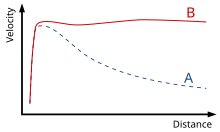

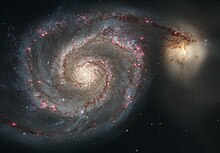
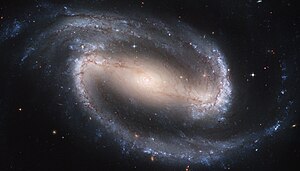
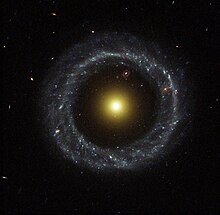

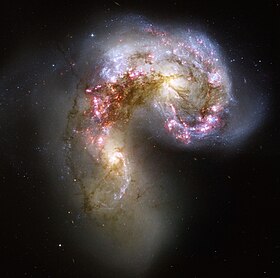



Tidak ada komentar:
Posting Komentar